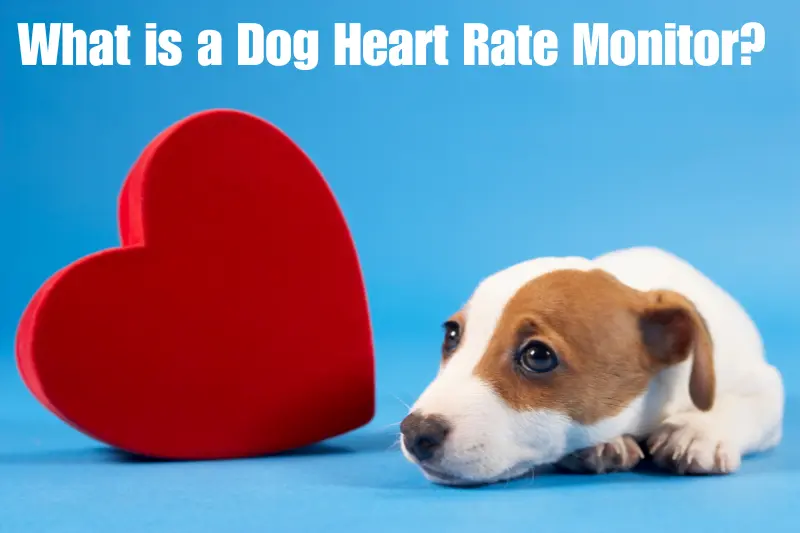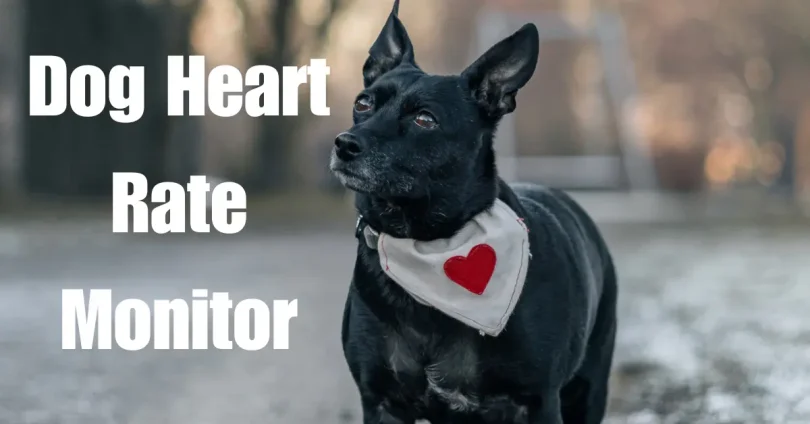As a pet parent, ensuring your dog’s health and wellness is a top priority. One of the most essential yet often overlooked indicators of your dog’s overall health is their heart rate. With advancements in pet health technology, the dog heart rate monitor has emerged as a powerful tool for keeping track of your canine companion’s cardiovascular and general well-being.
In this detailed guide, we’ll explain what a dog heart rate monitor is, why it’s important, how it works, the types available, and how to choose the best one for your furry friend.
What is a Dog Heart Rate Monitor?

A dog heart rate monitor is a device that measures your dog’s heartbeats per minute (BPM). It works similarly to human heart rate monitors by using sensors to detect heart activity, either through optical signals or electrical impulses. The data is then displayed on a screen or sent to a mobile app for easy tracking.
These monitors are usually built into wearable devices like smart collars, chest straps, or harnesses. They are designed to be non-invasive, comfortable, and suitable for dogs of all sizes. Beyond heart rate, many models also track other health indicators such as respiration, activity, and temperature, helping pet owners and vets monitor your dog’s health more effectively.
Why Monitoring Your Dog’s Heart Rate is Important
Monitoring your dog’s heart rate can provide key insights into their health. Here’s why this device is more than just a gadget:
1. Detects Health Issues Early
Changes in heart rate can indicate underlying health issues like:
- Heart disease
- Respiratory issues
- Infections
- Pain or discomfort
- Heatstroke
Spotting these signs early allows for faster diagnosis and treatment.
2. Tracks Fitness and Activity
Heart rate monitors are especially helpful for:
- Active dogs
- Working or service dogs
- Dogs involved in agility training
They help ensure your pet is not overexerted during physical activities.
3. Manages Anxiety and Stress
Sudden spikes in heart rate may indicate anxiety or fear, which is common in situations such as:
- Thunderstorms
- Fireworks
- Traveling
- Separation from owners
Monitoring helps owners and vets manage and treat canine anxiety more effectively.
4. Aids in Post-Surgery Recovery
After surgery or medical treatments, monitoring heart rate helps track recovery progress and identify complications before they become serious.
Normal Heart Rate for Dogs
Understanding your dog’s normal heart rate is crucial for using a heart rate monitor effectively. The average resting heart rate varies by size and age:
| Dog Type | Normal Resting Heart Rate (BPM) |
| Small Breeds | 100 – 160 BPM |
| Medium Breeds | 80 – 120 BPM |
| Large Breeds | 60 – 100 BPM |
| Puppies | 120 – 160 BPM |
During exercise or excitement, it’s normal for the heart rate to rise temporarily.
How Dog Heart Rate Monitors Work
Dog heart rate monitors use different types of technologies to accurately detect and measure your dog’s heart activity. The most common methods include:
1. Electrocardiography (ECG):
ECG technology measures the electrical signals generated by the heart as it beats. Small electrodes in the device pick up these electrical impulses and translate them into heart rate data. This method is very precise and is often used in medical-grade monitors.
2. Photoplethysmography (PPG):
PPG uses light-based sensors to track changes in blood flow under the skin. The sensor emits a light beam (usually green or infrared), and by measuring how much light is absorbed or reflected, it can detect the pulse and calculate the heart rate. This technique is commonly found in smart collars and wristbands.
3. Acoustic Sensors:
These sensors listen for the actual sound of the heartbeat. Using microphones or specialized sound detectors, they pick up the rhythmic beating and convert it into heart rate readings. This method can be useful for non-contact devices.
You may also like to read this:
Buy Dog Tech Gear Online – Top Tech For Dogs In 2025
Top Dog Wearable Devices For Health And Safety In 2025
Top Smart Pet Health Monitors For Better Pet Care
Best Pet Fitness Tracking Devices For Health & Safety 2025
Pet Health Apps with AI: Transforming Pet Care In 2025
How Tech For Monitoring Pet Vitals Improves Pet Health
4. Radar and Infrared (IR) Sensors:
Some advanced monitors use radar or infrared technology for completely contactless heart rate monitoring. These sensors detect subtle chest movements or heat changes caused by the heartbeat, allowing for monitoring without wearing a device directly on the dog.
Once the data is collected, it is transmitted in real-time to a paired smartphone app or a dedicated monitoring device via Bluetooth or Wi-Fi. The app processes the information and displays heart rate trends, alerts for abnormal readings, and health reports, enabling pet owners to track their dog’s cardiovascular health continuously and make informed decisions.
Types of Dog Heart Rate Monitors

1. Smart Collars
These all-in-one devices monitor heart rate, respiration, body temperature, activity, and even GPS location.
- Best for: Everyday use and long-term tracking.
- Example: PetPace Smart Collar, Fi Smart Collar Series 3
2. Chest Strap Monitors
These wrap around the dog’s chest, offering accurate and stable readings during exercise or vet evaluations.
- Best for: Sporty or working dogs, veterinary use.
3. Harness-Based Monitors
Integrated into a walking harness, these provide convenient access to heart rate and activity data.
- Best for: Comfortable monitoring during walks or outdoor activities.
4. Contactless Monitors
Using radar, thermal imaging, or camera tech, these devices monitor heart rate without touching the dog.
- Best for: Anxious or medically sensitive dogs.
Key Features to Look for in a Dog Heart Rate Monitor
When choosing a dog heart rate monitor, several important features can help ensure you get accurate, reliable, and comfortable health tracking for your pet:
✅ Accuracy
Accuracy is the most critical factor in any heart rate monitor. Look for devices that have been clinically tested or recommended by veterinarians. Accurate readings help you trust the data for detecting potential health issues early and making informed decisions about your dog’s care.
✅ Real-Time Monitoring
Devices that offer live, real-time heart rate tracking provide immediate updates. This allows you to quickly respond to any sudden changes, such as spikes or drops in heart rate, which could indicate distress or medical emergencies.
✅ Mobile App Integration
Most modern dog heart rate monitors connect to smartphone apps, giving you a convenient way to manage your dog’s health data. Good apps allow you to:
- Track trends over time to see how your dog’s heart rate changes during exercise, rest, or stress.
- Set customized alerts that notify you if your dog’s heart rate moves outside normal ranges.
- Share data easily with your veterinarian for professional analysis and advice.
✅ Comfort and Fit
A monitor should be comfortable enough for your dog to wear all day without irritation. Choose devices that are lightweight, breathable, and have adjustable straps to fit your dog’s size perfectly. A secure but gentle fit prevents slipping and ensures consistent readings.
✅ Durability and Battery Life
Since dogs can be active and adventurous, durability is essential. Waterproof and rugged devices withstand outdoor activities and accidental exposure to water or dirt. Long battery life or rechargeable options reduce the hassle of frequent charging or replacements, allowing continuous monitoring.
✅ Additional Health Tracking
Many advanced monitors don’t just measure heart rate—they offer a broader health overview by tracking:
- Respiration rate, helping detect breathing difficulties or stress.
- Body temperature, to spot fevers or hypothermia early.
- Calories burned, useful for managing weight and fitness.
- Sleep patterns, indicating rest quality and potential health problems.
- Behavior and posture monitoring, which can reveal signs of discomfort, pain, or anxiety.
These extra features provide a more comprehensive picture of your dog’s well-being beyond just the heart rate.
Best Dog Heart Rate Monitors in 2025
🏆 PetPace Smart Collar
- Features: Tracks heart rate, temperature, respiration, and pain indicators.
- Pros: Vet-approved, real-time data, alerts via app.
- Ideal for: Senior or ill dogs, long-term health monitoring.
🏆 Fi Smart Collar Series 3
- Features: GPS, activity tracking, and heart rate.
- Pros: Waterproof, great battery life, stylish.
- Ideal for: Active dogs and outdoor adventures.
🏆 Whistle Health Collar
- Features: Heart and respiratory rate, sleep tracking, behavior monitoring.
- Pros: Easy-to-use app, vet connectivity.
- Ideal for: Everyday pet care and wellness tracking.
How to Use a Dog Heart Rate Monitor Properly
Step-by-Step Guide:
- Read the Manual: Understand the correct placement and setup process.
- Attach Properly: Ensure snug but comfortable fit to avoid slipping or discomfort.
- Connect to App: Sync the monitor to your smartphone (if applicable).
- Track Regularly: Monitor during rest, activity, and stressful situations.
- Review Data Trends: Use the app or logs to identify patterns or changes.
- Consult Your Vet: Share data with your vet for professional analysis if anything unusual is detected.
Tips for Getting the Most Out of Your Dog Heart Rate Monitor
- Consistency is Key
Regular monitoring provides the best insights. Try to check your dog’s heart rate at similar times daily—such as during rest, before and after exercise, and in situations where stress might occur. - Know Your Dog’s Baseline
Establish what your dog’s normal heart rate looks like when calm and healthy. This baseline helps you quickly recognize any deviations that may indicate a problem. - Avoid Stress During Measurement
Try to keep your dog relaxed when taking measurements. Stress or excitement can temporarily elevate heart rate, leading to false alarms. - Combine with Other Health Indicators
Use heart rate data alongside observations of behavior, appetite, energy levels, and other symptoms for a comprehensive health picture. - Keep the Device Clean and Maintained
Regularly clean the sensors and charging ports to ensure accuracy and longevity of the device. - Use Alerts Wisely
Set appropriate thresholds on your device app so you receive alerts only for truly abnormal heart rates, avoiding unnecessary panic.
When to Contact a Veterinarian
While dog heart rate monitors are valuable tools, they are not substitutes for professional veterinary care. Contact your vet if you notice any of the following:
- Persistent abnormal heart rates (too fast, too slow, or irregular)
- Signs of distress such as difficulty breathing, lethargy, collapse, or pale gums
- Sudden changes in heart rate without clear cause (e.g., not linked to exercise or excitement)
- Any other concerning symptoms alongside heart rate changes
Sharing heart rate data collected from your monitor can assist your veterinarian in making a faster and more accurate diagnosis.
Conclusion
A dog heart rate monitor is an essential tool for every pet owner who wants to keep a close eye on their dog’s health. By providing real-time and accurate heart rate data, these devices help detect potential health issues early, track fitness levels, manage anxiety, and support recovery after medical treatments. Choosing the right dog heart rate monitor with features like comfort, durability, and app integration ensures you get the most reliable and convenient monitoring experience.
Consistent use of a dog heart rate monitor combined with regular veterinary check-ups allows you to take proactive steps in maintaining your dog’s well-being. While these monitors enhance your ability to care for your dog, they should always complement professional veterinary advice. Using a dog heart rate monitor is a smart way to ensure your furry friend stays healthy, happy, and active for years to come.
FAQs
1. What is a dog heart rate monitor?
A dog heart rate monitor is a device designed to measure your dog’s heartbeats per minute (BPM). It helps track your pet’s cardiovascular health by detecting heart activity through sensors built into collars, harnesses, or chest straps.
2. Why should I use a dog heart rate monitor for my pet?
Using a dog heart rate monitor helps detect early signs of health issues, track fitness levels, manage anxiety, and monitor recovery after surgery. It gives real-time data to keep your dog’s heart health under constant observation.
3. How accurate are dog heart rate monitors?
The accuracy varies by device, but most clinically tested or vet-recommended dog heart rate monitors provide reliable and precise readings when used correctly.
4. Can I use a dog heart rate monitor on any breed or size?
Yes, many dog heart rate monitors come with adjustable straps and different sizes, making them suitable for dogs of all breeds and sizes.
5. How do I choose the best dog heart rate monitor?
Look for accuracy, comfort, real-time monitoring, app integration, durability, battery life, and extra health tracking features when selecting the best dog heart rate monitor.



